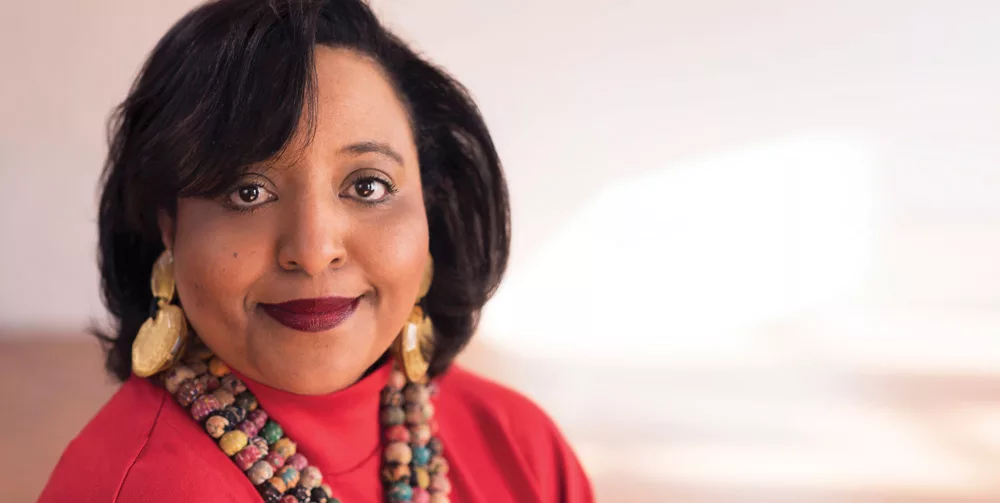Women of color are the fastest-growing population of entrepreneurs in the United States. As of last year, more than 5 million Black, Latina, Asian, and Native American women sat at the helms of their own companies — pulling in $360 billion in revenue — and women of color now start between 600 and 800 new businesses every day. Yet despite their growing prevalence and success, funding opportunities for businesses owned by minority women are few and far between.
Overall, women entrepreneurs receive only about 3 percent of annual venture capital funding, despite the fact that women start companies at twice the rate of men. The landscape for female entrepreneurs of color is even more difficult — they attracted 0.2 percent of all VC funding in 2015. If investors funded them on the same level as even white women, female founders of color would have generated $1.1 trillion in revenues last year. “Those first critical dollars just aren’t there,” says Gayle Jennings O’Byrne, founder and CEO of iNTENT Manifesto.
Inspired to change the statistics, Jennings O’Byrne did what many deem unthinkable — she left a coveted Wall Street job (VP of Global Philanthropy at JPMorgan Chase) to strike out on her own.
Trailblazing is nothing new for Jennings O’Byrne and her family. When her mother, Thelma Bataille, was a high school senior, she was asked to transfer to an all-white school nearby — the same school that had rejected her brother four years earlier because of his race — to help desegregate it. “Much like the civil rights archival footage that you see in videos, there were mobs,” Jennings O’Byrne said of Bataille’s experience facing new students at the school. “They were cursing at these children.”
Although she was poised to become valedictorian of her segrated senior class, Bataille accepted the risks of being at the forefront of integration to ensure the school could never again reject deserving students like her brother because of the color of their skin. Even though she was the only black person — and often the only girl — in her classes, she not only survived but thrived. She graduated with honors, attended college, and eventually landed a job at McDonnell Douglas, where she worked on coding for DC-10 air tankers and M-15 fighter planes. She later spent 30 years working in Silicon Valley. “For me, she was one of those ‘Hidden Figures’ that you see on film, and her story motivated me to take a chance in my own life,” Jennings O’Byrne says.
Jennings O’Byrne’s latest venture, iNTENT Manifesto, calls on financiers, investors, and other stakeholders to support minority women founders and shares the stories of successful female entrepreneurs of color. “We have to start telling their stories so they’re no longer hidden figures,” Jennings O’Byrne says. “We have to show the world this population matters.”
She hopes to gather one million signatures for the Manifesto and build out a network to help women of color find funding through projects like the Prometheus Exchange and Project Diane. “Our big vision is to move a billion dollars’ worth of investment into women-of-color startups,” she says.
In March, she moved one step closer to her goal when her former Wall Street employer, JPMorgan Chase, funded the iNTENT Manifesto to the tune of half a million dollars. Conscious Company spoke with with the courageous entrepreneur, change-maker, and cancer survivor to find out what it’s like to leave a job you love to pursue your passion — and how it feels to attract your old employer’s support.
You worked on Wall Street for almost 20 years. Now, JPMorgan Chase is a partner on your new venture. How does it feel to have your former employer support your work, and what is it like partnering with such a giant corporation?
Gayle Jenning O’Byrne: I decided to leave JPMorgan — a career and employer that I loved — to join the front lines of advocating for women entrepreneurs of color, specifically tech entrepreneurs, and telling their stories. It wasn’t long before my team at JPMorgan invited me back to talk about what I was doing. When I shared the work with them, they got behind me right away, and we spent the next year deciding how we could collaborate. I’m proud of my former employer not only for their commitment to small business and women of color, but also for their support of a former employee.
Now, I have been on both sides. I’ve worked inside the company as a partner, and now I’m on the outside partnering with the company. Through that experience, I learned that champions are everything and it’s critical to find more than one champion within a partner organization. I’m very intentional about building a matrix of people within the company who are genuinely excited about iNTENT Manifesto and what we do. Many people at the company want to help — the will and commitment is there — but everyone has their own to-do list to worry about. The best way to keep moving forward is to build relationships with a group of champions who are committed to the work.
How do you go about recruiting champions within a partner organization? Do you have a method for getting someone excited about your work?
GJO’B: It sounds hokey, but the best way to find a champion is to listen. As with any relationship, making a connection is all about listening to the other person and understanding his or her motivation and definition of success.
For instance, I recently met a JPMorgan team member for the first time. We sat down, and she told me what she enjoys about her job, the projects she’s working on, the performance goals she needs to meet, and what gets her excited. She talked and I listened, and it completely changed the conversation. We tinkered out some ideas that benefit both of us, as opposed to me pitching her about the help I need from my corporate partner. She probably has a hundred things on her to-do list already, so rather than put more on her plate, we focused on how the project can help her with the work she’s already doing.
Listening opens the door, but it’s also important to have an ask. Suggest some homework. We’re all busy, but if you have an ask and ideas for next steps, people will be more willing to help than if you leave the conversation open-ended.
It makes sense to go into a meeting with an ask in mind. Can you give us an example of a good ask for a potential partner or champion?
GJO’B: Start with something easy. Right now, we’re asking people to sign the Manifesto. It takes all of 38 seconds, it’s on the front page of our website, and I always have it on my phone. If someone I speak with says, “I would love to do that,” I just hand them my phone and away we go. The simpler the ask, the more you’ll find people are willing to help.
For homework and next steps, you can go a bit deeper, but make it as seamless as possible for the other person. We’re building a tribe and a community, which involves a lot of introductions and conversations that inspire people to care about this work. Making an introduction is an easy ask, but the last thing anyone wants to think about is how to pitch my idea to another person, so I provide a blurb they can use in their emails.
Finally, I always end my conversations with, “How can I help you?” It’s a simple question, but I find it so beautiful because people don’t expect it. A certain calm comes over them, because I’m expressing authentic care. I love seeing how people respond.
What motivates you to continue advocating for women entrepreneurs of color, even when things get difficult?
GJO’B: At one point, it was a story of heartbreak. The women I advocate for have, in many ways, followed the rulebook of the American dream. They attended great colleges, they went on to work at Fortune 500 companies, and they started their own businesses. They did all of the things that are supposed to equal success, but now when they need the support of the financial market, they’re suddenly invisible. Society isn’t there to help them reach that last rung on the ladder.
It broke my heart because that’s me, that’s my mother — but my story isn’t about heartbreak anymore. Now, it’s a story of joy and glee. I’m living my fullest life. I get to bring my full self — the African-American woman, the Wall Street person, the geeky numbers girl — into my work each day. I see the beauty in the women entrepreneurs I work with and the people who support them.
How did you move away from that place of heartbreak and frustration to where you are now? Was there a certain moment or mindset shift?
GJO’B: I got into a new morning routine a couple of years ago. It starts with meditation and journaling, and then I write a thank-you note for one person each day.
I don’t want to make it sound like I’m an uber-enlightened person who has all the answers. I meditate for a few minutes, and I usually struggle to keep my to-do list out of my head. My journaling is often as little as half a page. Even though it’s not perfect, that morning ritual brings me to a place of inner calm. It helps me let go, trust the universe and the people around me, and be confident that good will prevail. It reminds me that if I come from a place of authenticity, have empathy in my work, and care about others, good things will happen and I will be made whole as a part of it.
Likewise, writing a thank-you note helps me focus on what I’m grateful for each day and gives me a chance to tell other people I appreciate them. Time after time, day after day, those little reminders moved me to a place of joy.
What inspired you to start a mindful morning routine?
GJO’B: I started it shortly after my cancer diagnosis. I went home to Northern California over the Easter holiday to tell my family, and the first question my brother asked was, “Are you meditating?” He had spent the past couple of years living in Thailand and Cambodia, and I’d say he’s the more enlightened, spiritual one in our family. When he said that, I realized I’d never meditated and didn’t even know how, so I Googled meditation and set down the path of exploring how it could work for me.
Then I found Mindful Harlem, a group meditation class and workshop that meets on Saturday mornings in Harlem, New York. It became a lovely community for me and helped me learn to practice meditation and have empathy for others.
Do you see a connection between your move toward mindfulness and meditation and your decision to leave a job you loved to pursue another calling?
GJO’B: One of my life coaches once said, “So much of what we do is out of fear.” He told me I was procrastinating. I was putting things off, and not necessarily because I didn’t want to do them, but because I was afraid. He challenged me, “What if you tackle the things that you’re most fearful of first?”
When I was diagnosed with cancer, I remember being terrified of dying. I didn’t want to miss anything, so I started to observe everything. I probably stared at people longer than I should have, but I was taking mental pictures. I took a bite of food and savored it, because I wanted to remember how it tasted. I smelled my husband’s T-shirts so I’d never forget him. I memorized people’s laughs. Then I got to a point where I stopped being afraid of dying, because I was capturing it all. I knew I’d never forget. In that moment when the fear of not being on this earth faded away, I decided to do something I’d always been afraid of — leave corporate America and dedicate myself to something I feel strongly and passionately about.
I knew I had to leave JPMorgan, and I asked myself, “What do I care about?” Maybe it’s narcissistic, but I care about women like me. I stopped being afraid and recognized that I had the tools I needed to be a successful champion for women. Now, I wake up unshakeable in my belief that we can move a billion dollars toward investments in women entrepreneurs. I believe people will stand with us, and I know our work is good for the economy. Our mission just needs champions. I decided to be one of them.
What have you learned since leaving corporate America to pursue your dream of empowering women of color in business?
GJO’B: The beautiful thing is, I am not alone. This conversation is taking place all over the world. I recently attended a conference at the Nobel Peace Center in Oslo, Norway, where we talked about empowering minority women and their role in the technology trends like blockchain and cryptocurrency. I just returned from Dallas, where I met with JPMorgan executives to talk about women entrepreneurs of color.
I feel the time has come — we have a window in which to show success. The world will rise up to meet us, but we have to show them the on-ramp to this inclusion highway. It starts with good stories, good investments, and good companies. You don’t bring people into an idea or a movement by bombarding them with statistics. You engage people by helping them see themselves in the story and see their role in the solution as opposed to their role in the problem.
The stories we tell are for everyone, and I’m pleased they’re being received that way. It’s exciting to see a Wall Street guy have an aha moment and say, “I get it. I see myself in this story. I’m inspired by this company. I think this technology is really cool. How can I help?” That’s the piece I love, because in many ways this is the story of us. It’s not a them story. It’s not a those women story. It’s a story about us. I’m just lucky to do my little part, and I’m having fun as well.
Learn More: Video Extra about iNTENT Manifesto
Intent Manifesto – Branded Video from Digital Bodega on Vimeo.




